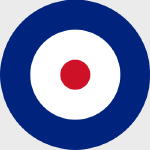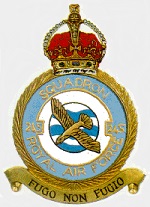Corgi AA36512 RAF Hawker Typhoon Mk. Ib Ground Attack Aircraft - MN625/MR-B, No.245 (Northern Rhodesian) Squadron, Homesley South Airfield, Hampshire, June 1944 [75th Anniversary of the D-Day Invasion] (1:72 Scale)
"Never in the field of human conflict was so much owed by so many to so few."
- British Prime Minister Winston Churchill, commenting on the British airmen in the Battle of Britain
 The Typhoon was a British single-seat strike fighter, produced by Hawker Aviation starting in 1941. Intended as a replacement for the Hawker Hurricane in the interceptor role, it suffered from performance problems, but eventually evolved into one of World War II's most successful ground attack aircraft.
The Typhoon was a British single-seat strike fighter, produced by Hawker Aviation starting in 1941. Intended as a replacement for the Hawker Hurricane in the interceptor role, it suffered from performance problems, but eventually evolved into one of World War II's most successful ground attack aircraft.
Even before the new Hurricane was rolling off the production lines in March 1937, Sidney Camm had moved on to designing its future replacement as a private project. This was to be a massive plane designed around the equally massive Napier Sabre engine. The work proved useful when Hawker received specification F.18/37 in January 1938 from the Air Ministry, which asked for a fighter based around either the Napier Sabre or the Rolls-Royce Vulture engine. The engines were similar in that they were both 24 cylinder designs that were designed to deliver over 2,000 hp (1.5 MW), and different primarily in the arrangement of the cylinders - an H-block in the Sabre and an X-block in the Vulture.
The two resulting models became known as the 'R' and 'N' (based on the engine manufacturer) and were very similar - the Vulture powered R plane had a rounder nose profile and a ventral radiator, whereas the Sabre powered N had a flatter deck and a chin mounted radiator. The basic design of both continued the Hawker tradition of using 'older' construction techniques; the front fuselage was welded steel just like the Hurricane, and the design used a massive 40 foot (12 m) wing that was much thicker than those on designs like the Spitfire. Camm did give in to the times for much of the rest of the plane though; it was semi-monocoque from the cockpit rearward, flush riveted, and had wide set gear. Instead of sliding or lifting canopy the Typhoon came with a side door.
The R version first flew in October 1939, and the RAF was so impressed they ordered 1,000 as the Tornado. Various problems, notably compression effects which were previously unknown to Hawker, slowed the acceptance down. In addition the plane had rather disappointing climb performance, which meant it wouldn't be the Spitfire-replacing interceptor they were looking for. In February 1940 the first N model, now known as the Typhoon, was delivered. The RAF placed a large order for it as well, but moved production to Gloster Aircraft who had no designs to produce at the time. Like the Tornado, the Typhoon was soon demonstrating its own problems, including vibrations from the engine causing the wing's skin to peel.
Eventually the RAF cancelled all work on both models in May 1940 so that Hawker could concentrate solely on the Hurricane during the Battle of Britain. This was the design's first brush with death. Some small-scale work continued, changes to streamline the fuselage and supply a much thinner wing were looked at, as well as alternate engines in the form of large radials. In October pressure on the RAF eased and work was allowed to continue on the two original designs.
The first full production version Tornado was delivered in early 1941 and demonstrated the then unheard of speed of 425 mph fully armed. This was also the last Tornado. While production lines were being drawn up, the Vulture engine project was suddenly terminated by Rolls-Royce and the Tornado was left without an engine. However the Typhoon had 'good enough' performance to warrant production. The first production Mk.IA was delivered in May 1941 with twelve Browning .303 guns, but this was followed quickly with the Mk.IB with four Hispano 20 mm cannons.
By this time the Spitfire Vs were meeting Focke-Wulf Fw 190s in combat and getting rather beaten up, so the Typhoon was rushed into squadron service (with 56 & 609 Sqn) to counter the new German plane. Sadly this proved to be a disaster. An apparent structural weakness in the tail meant that it tended to break off when pulling out of dives, the Fw's favourite escape. Once again there was talk of killing the design. The cause of these tail-failures (in which only one of the pilots survived to give any clue to the reason) was found to be fatigue failure of the elevator mass-balance, allowing elevator-flutter to occur which was at its greatest when pulling-out of a dive. As a "temporary" measure, rectangular strengthening "fishplates" were riveted around the fuselage/empennage joint - the site of the failures. These fishplates remained a feature on all subsequent Typhoons. Problems with leakage of exhaust fumes into the cockpit and subsequent high carbon monoxide levels meant Typhoon pilots had to use oxygen for even low level operations. Due to the efforts of operational pilots like S/L Roland Beamont (of 609 Sqn) the Typhoon continued under development despite these design drawbacks.
This particular 1:72 scale aircraft was flown by No.245 (Northern Rhodesian) Squadron, then deployed to Homesley South Airfield, Hampshire, during June 1944.
Sold Out!
Dimensions:
Wingspan: 7-inches
Length: 5-1/4-inches
Release Date: May 2019
 Historical Account: "Ground Support" - If the Douglas C-47 Skytrain is considered the most famous multi-engine aircraft of D-Day aerial operations, then the single-engine equivalent must be the fearsome Hawker Typhoon. Agile and extremely heavily armed, the Typhoon was to see plenty of action during the summer of 1944, either attacking strategic targets in the weeks prior to invasion, such as German radar sites or providing invaluable close air support to ground units breaking out from the landing beachheads.
Historical Account: "Ground Support" - If the Douglas C-47 Skytrain is considered the most famous multi-engine aircraft of D-Day aerial operations, then the single-engine equivalent must be the fearsome Hawker Typhoon. Agile and extremely heavily armed, the Typhoon was to see plenty of action during the summer of 1944, either attacking strategic targets in the weeks prior to invasion, such as German radar sites or providing invaluable close air support to ground units breaking out from the landing beachheads.
With forward air controllers installed with ground units throughout Normandy, RAF Typhoons were ready to respond to any request for aerial support, with aircraft not already engaged in strike missions holding off the coast of Northern France, ready to be called into action. These missions proved to be incredibly hazardous for Typhoon crews, not so much down to the attention of Luftwaffe fighters, but from the murderous anti-aircraft fire hurled in their direction from seemingly every German gun in the Normandy region. Indeed, in the weeks following the D-Day landings, more than 500 Hawker Typhoons had been lost, less than 10% of which were attributed to enemy fighter attack. Flying at high speed and at extremely low level, the opinion shared by Typhoon crews was that you had not experienced real combat flying until you had spent time on a Typhoon squadron.





 RAF Hawker Typhoon
RAF Hawker Typhoon 


